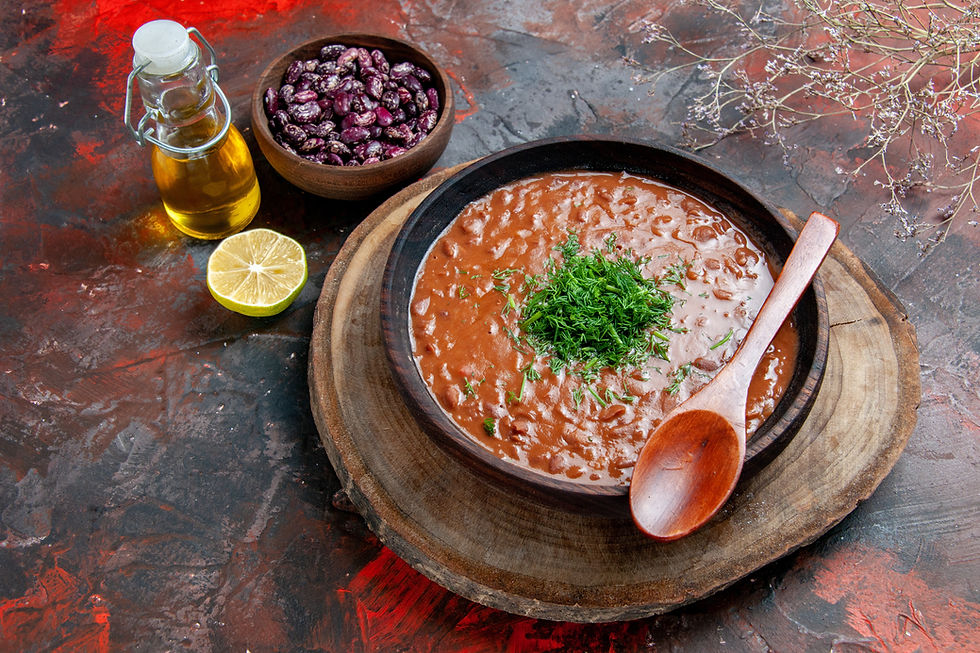South American Soup Ingredients for Gut Health
- Kellen Day
- Jul 1
- 3 min read

Mornings and evenings alike can be the perfect time to explore vibrant flavors and gut-loving nutrition in one bowl. South American soup ingredients—from ancient grains to tropical tubers—offer a unique palette of fibers, polyphenols, and prebiotics that experimental cooks will love. By incorporating these elements into your recipes, you can support your gut microbiome while enjoying warming, soul-satisfying soups. Whether you’re curious about soup cleansing or simply eager to diversify your culinary repertoire, read on to discover how these ingredients can transform your next pot of soup into a microbiome-friendly masterpiece.
Why South American Soup Ingredients?
South America is home to thousands of edible plants that have been cultivated over millennia by Indigenous cultures. Many of these traditional foods are naturally rich in fermentable fibers and phytonutrients that feed beneficial gut bacteria. For example, yacón root contains fructooligosaccharides—a type of prebiotic fiber that has been shown to boost the populations of Bifidobacteria and Lactobacilli, which produce short-chain fatty acids essential for maintaining intestinal barrier integrity and reducing inflammation. Using South American soup ingredients in your recipes isn’t just about global flavors—it’s a science-backed way to nourish your digestive ecosystem.
Key South American Soup Ingredients
Quinoa:
This Andean “super grain” is a complete protein. It contains resistant starch that survives digestion in the small intestine and reaches the colon to feed beneficial microbes.
Yacón Root:
Sometimes called the “ground apple,” yacón’s high fructooligosaccharide content acts as a prebiotic, selectively stimulating the growth of helpful gut bacteria.
Black Beans:
Rich in soluble fiber and resistant starch, black beans help regulate blood sugar levels and promote diversity in the gut microbiome, which is crucial for maintaining long-term digestive health.
Maize (Corn):
In its whole-kernel form (such as mote or hominy), maize provides a mix of fibers and polyphenols that support microbial balance and antioxidant protection in the gut lining.
Achiote (Annatto):
This bright red seed adds color and mild earthiness. It contains tocotrienols—compounds related to vitamin E—that exhibit antioxidant and anti-inflammatory properties.
Gut-Science Backed Benefits
Including South American soup ingredients in your diet offers multiple gut-health advantages:
Enhanced Microbial Diversity: Diets high in varied plant fibers increase the richness and evenness of gut microbial communities, which is linked to a reduced risk of inflammatory and metabolic diseases.
Improved Barrier Function: Short-chain fatty acids (SCFAs) produced by bacterial fermentation of resistant starches and prebiotics strengthen tight junctions in the intestinal lining, helping prevent “leaky gut.”
Balanced Immune Response: Nearly 80% of immune cells reside in the gut; a healthy microbiome educates these cells to distinguish between harmless and harmful stimuli, reducing chronic inflammation and supporting systemic health.
Tips for Experimental Cooks
Combine Wisely: Pair quinoa or maize with legumes (like black beans) in brothy bases to balance proteins, fibers, and micronutrients.
Layer Flavors: Start your soup with sautéed garlic, onions, and achiote paste dissolved in olive oil—this releases fat-soluble phytonutrients and builds depth.
Mind the Texture: Use yacón root in thin matchsticks or grated form so it softens quickly yet retains its prebiotic benefits.
Batch Prep for Soup Cleansing: If you’re exploring soup cleansing, prepare large pots of a bean-and-grain soup featuring these ingredients. Freeze individual portions to maintain convenience and consistency throughout your cleanse days.
Garnish with Microgreens: Top each bowl with cilantro, parsley, or amaranth greens for a fresh boost of polyphenols and chlorophyll.
Incorporating into Your Routine
Weekly Rotation: Aim to cook at least two recipes per week featuring South American staples.
Flavor Variations: Swap out grains, legumes, or spices in each batch to keep meals exciting and maximize the variety of fibers and antioxidants.
Mindful Enjoyment: Savor each spoonful slowly—mindful eating enhances digestive enzyme activity and signals satiety hormones more effectively.










Comments